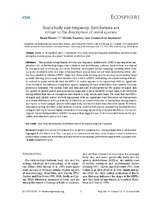| dc.contributor.author | Maritz, Bryan | |
| dc.contributor.author | Kgaditse, Mimmie | |
| dc.contributor.author | Alexander, Graham John | |
| dc.date.accessioned | 2018-10-03T12:56:38Z | |
| dc.date.available | 2018-10-03T12:56:38Z | |
| dc.date.issued | 2016 | |
| dc.identifier.citation | Maritz, B. et al. (2016). Snake body size frequency distributions are robust to the description of novel species. Ecosphere, 7(5): e01348. | en_US |
| dc.identifier.issn | 0018-8158 | |
| dc.identifier.uri | http://dx.doi.org/10.1002/ecs2.1348 | |
| dc.identifier.uri | http://hdl.handle.net/10566/4090 | |
| dc.description.abstract | The accurate interpretation of body size frequency distributions (BSFDs) has important implications
for understanding large-scale
ecological and evolutionary patterns because they are shaped
by ecological and evolutionary processes. However, incomplete species sampling, resulting either from
a paucity of reliable body size data or because those species have not yet been detected/described, also
has the potential to influence BSFD shape and skew when missing species are disproportionately large
or small. Missing species may thus influence the skew of a BSFD, misleading subsequent interpretations.
In contrast to many vertebrate taxa, the BSFDs of snakes appears to be log-normal,
with no significant
skew. However, the influence of imperfect species sampling on these distributions has however not been
previously evaluated. We collated body size data and date of description for 300 species of elapid, and
264 species of viperid snakes and assessed the shape and skew of the BSFD of each clade. Next we tested
the hypothesis that date of description was related to body size in each clade. We show that the BSFDs
of elapid and viperid snakes are both log-normal,
with no significant skew. Moreover we demonstrate
size-related
differences in the probability of detection (as measured by year of description) among elapids
and vipers: in both lineages, species with larger body size tend to have been described earlier. However,
simulations testing the effect of the addition of novel, small-bodied
species revealed that the distributions
of elapids and vipers are not highly vulnerable to becoming significantly skewed in the future. Our results
support current interpretations of BSFDs in snakes that suggest a lack of size-associated
biases in the speciation
and extinction rates of this clade. | en_US |
| dc.language.iso | en | en_US |
| dc.publisher | Ecological Society of America | en_US |
| dc.subject | Bias | en_US |
| dc.subject | Body size frequency distribution | en_US |
| dc.subject | Date of description | en_US |
| dc.subject | Elapidae | en_US |
| dc.subject | Viperidae | en_US |
| dc.title | Snake body size frequency distributions are robust to the description of novel species | en_US |
| dc.type | Article | en_US |

